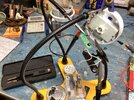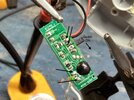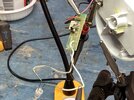Hafcanadian
New Member
I’m always having issues with my garden and patio LED lanterns, whether battery or solar powered. The one I’m trying to fix now is two AA powered. The lamp won’t come on at all, even though in the past it and its twin had funky switches. The switch seems okay this time, at least when I check continuity between its posts, and at one point I temporarily soldered in a larger switch that didn’t alter the result.
The board is cleaner than most that’ve been outside a lot, but the lamp won’t work. That said, if I set my LCR tweezers to “Diode” and put the tips across the lamp’s leads, the LED flashes (not flickers), so the LED seems okay. It’s flickering candle imitation must be controlled by a board component, or under normal voltage it may be the lamp’s built-in mode.
I note a “crystal”(?) can on the back of the board.
See photos and please advise what to check.
Thanks.
The board is cleaner than most that’ve been outside a lot, but the lamp won’t work. That said, if I set my LCR tweezers to “Diode” and put the tips across the lamp’s leads, the LED flashes (not flickers), so the LED seems okay. It’s flickering candle imitation must be controlled by a board component, or under normal voltage it may be the lamp’s built-in mode.
I note a “crystal”(?) can on the back of the board.
See photos and please advise what to check.
Thanks.






